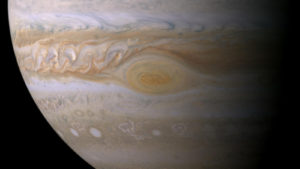 Jupiter’s iconic “Great Red Spot” is a storm belonging to a scale completely outside of Earth’s experience. This blazing-red anticyclone has more than triple of the windforce of the jetstream, could contain the entirety of planet Earth within itself and has been raging for so long, a minimum of 187 years, that it could continue frenzying for many generations to come. While scientists have not yet been able to discern the source of the Great Red Spot’s longevity or the chemical composition that results in its ruddy coloration, they have discovered one new fact about this landmark: its depth. After two years of orbiting Jupiter, the Juno craft has been able to verify that the Great Red Spot extends 217 miles into the planet.
Jupiter’s iconic “Great Red Spot” is a storm belonging to a scale completely outside of Earth’s experience. This blazing-red anticyclone has more than triple of the windforce of the jetstream, could contain the entirety of planet Earth within itself and has been raging for so long, a minimum of 187 years, that it could continue frenzying for many generations to come. While scientists have not yet been able to discern the source of the Great Red Spot’s longevity or the chemical composition that results in its ruddy coloration, they have discovered one new fact about this landmark: its depth. After two years of orbiting Jupiter, the Juno craft has been able to verify that the Great Red Spot extends 217 miles into the planet.
Juno’s findings, including the storm’s depth, were made public last Monday at an American Geophysical Union meeting. Since Juno began gathering data in the summer of 2016, it has skimmed from the tops of Jupiter’s clouds and its radiation belts at the rate of one collection every 53 days. Andy Ingersoil, one of the Caltech planetary scientists involved with Juno, sees the Great Red Spot as a test bed for Earth-like weather models.
While it remains unclear what this new data means for future storm assessments, with many previous weather models fraying in analysis, the Spot has been gradually reducing since Voyager’s first scans in ’79. Voyager’s scans showed a storm that could swallow two Earths. Jupiter is wrapped in belts of radiation that extend beyond its clouds, resulting in a layer of charges particles that interact with its magnetic field.
Juno’s newest findings indicate the presence of a new radioactive region, located slightly above Jupiter’s equator, that exerts an even greater intensity of energy than the particles found within the radiation belt. It is theorized that these super-charged particles are a mixture of hydrogen, oxygen and sulfur; all of which are produced within the gas clouds of Jupiter’s moons, Io and Europa, but lose their electrons and become charged by interacting with Jupiter’s atmosphere.
Juno’s other Jupiter discoveries included:
-
- A second region of high-energy particles within the inner radiation belt whose electrons were nearly moving at lightspeed. This second group of particles is still being analyzed.
- 600-mile-wide cyclones along Jupiter’s poles.
- An uneven magnetic field whose strength varies from weak to 10 times the pull of anything on our planet.





